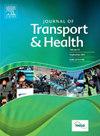Achieving a first detailed understanding of risky (motor)cycling behavior among Vietnamese adolescents: Findings from video elicitation focus groups
IF 3.2
3区 工程技术
Q2 PUBLIC, ENVIRONMENTAL & OCCUPATIONAL HEALTH
引用次数: 0
Abstract
Introduction
Vietnamese adolescents are at high risk on roads. There has been limited focus on the underlying motives for their risky (motor)cycling behaviors, particularly risky-prone circumstances from interactions with other road users in the local traffic environment. This study aims to explore risky behaviors among Vietnamese adolescents and the motives behind them, considering these behaviors as consequences of their interaction with the local traffic environment.
Methods
This study employed video elicitation focus groups to explore the risky (motor)cycling behaviors of Vietnamese adolescents and their underlying motives. Videos were recorded by adolescents to capture perspectives from both moped and motorcycle riders. Focus groups were conducted to gain insights into their behaviors and their motives, with responses categorized according to the research questions and sub-questions.
Results
Adolescents engaged in risky behaviors, such as riding in the wrong lane and dangerous overtaking, influenced by the risky behaviors from other road users (motorcyclists, cyclists, cars, pedestrians). They tend to mimic or avoid these behaviors by engaging on their own without careful consideration. Both objective and subjective safety can explain these situations.
Conclusion
Comprehensive strategies including education, engineering, and enforcement, are recommended to help educators, practitioners and policymakers enhance traffic safety among adolescents in Vietnam. Traffic safety education should focus on skill development and awareness of local traffic situations. Dedicated lanes for bikes and e-bikes should be established. Motorcycle Graduated Driver Licensed programs and stricter enforcement could help reduce illegal motorcycle use.
首次详细了解越南青少年的危险(机动)骑行行为:来自视频启发焦点小组的发现
越南青少年在道路上的风险很高。对他们危险(机动)骑行行为的潜在动机的关注有限,特别是在当地交通环境中与其他道路使用者互动的容易发生风险的情况下。本研究旨在探讨越南青少年的危险行为及其背后的动机,认为这些行为是他们与当地交通环境互动的后果。方法采用视频启发焦点小组的方法,探讨越南青少年的危险(机动)骑行行为及其潜在动机。视频由青少年录制,以捕捉轻便摩托车和摩托车骑手的视角。进行焦点小组以深入了解他们的行为和动机,并根据研究问题和子问题对回答进行分类。结果青少年逆行、超车等危险行为受到其他道路使用者(摩托车、自行车、汽车、行人)危险行为的影响。他们倾向于模仿或避免这些行为,不经过仔细考虑就自己参与其中。客观和主观安全都可以解释这些情况。结论建议采取包括教育、工程和执法在内的综合策略来帮助教育工作者、从业人员和政策制定者加强越南青少年的交通安全。交通安全教育应侧重于技能培养和对当地交通状况的认识。应该建立自行车和电动自行车专用车道。摩托车毕业驾驶执照计划和更严格的执法可以帮助减少非法摩托车的使用。
本文章由计算机程序翻译,如有差异,请以英文原文为准。
求助全文
约1分钟内获得全文
求助全文

 求助内容:
求助内容: 应助结果提醒方式:
应助结果提醒方式:


